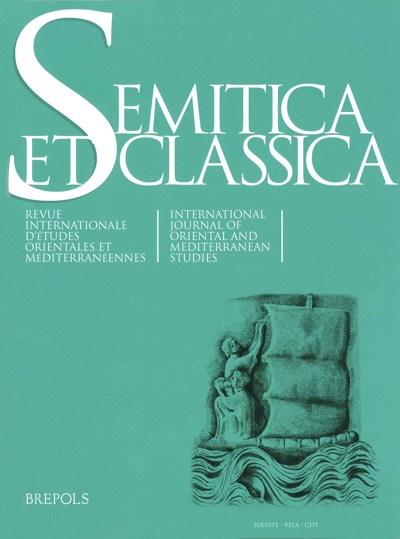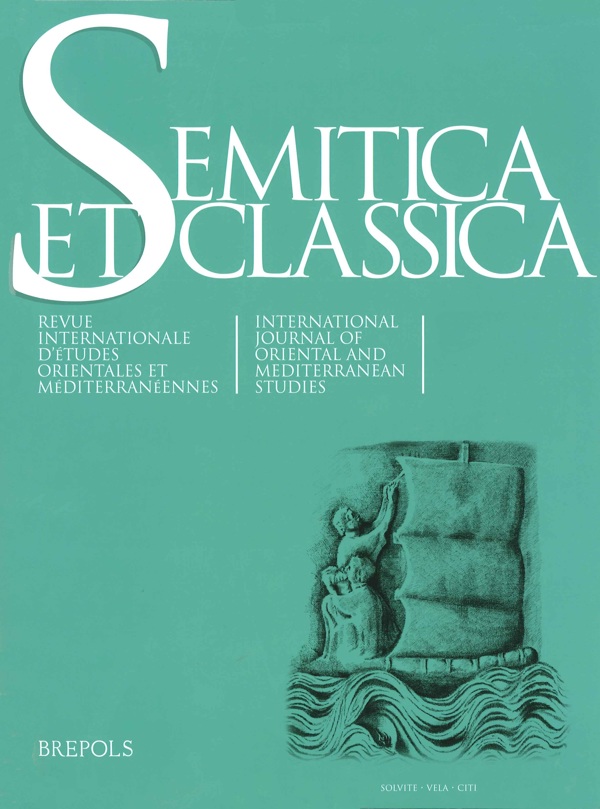
Semitica et Classica (2015)
International Journal of Oriental and Mediterranean Studies
Association Semitica et Classica (ed)
- Pages: 305 p.
- Size:216 x 280 mm
- Illustrations:84 b/w
- Language(s):French, English, Italian
- Publication Year:2015
- € 79,00 EXCL. VAT RETAIL PRICE
- ISBN: 978-2-503-54700-8
- Paperback
- Out of Print
- E-journal
- Available
Semitica et Classica, International Journal of Oriental and Mediterranean Studies, led by specialists in Eastern Mediterranean studies, philologists, archaeologists, epigraphists, philosophers, historians and linguists is directed to researchers with a particular interest in these areas of learning. The journal publishes work related to the interaction between the classical and Oriental worlds from the second millennium B.C.E. to the early centuries of Islam. The cultural area covered by the journal stretches from the western Mediterranean to the Middle East and includes Europe, Africa, and Asia up to and including the Arabian peninsula.
Articles
The hieros logos of Israelite circumcision in light of the text history of Josh 5,4-6: a study of intertwined textual and literary criticism (Adrian Schenker)
Biblical translations and cross-cultural communication: a focus on the animal imagery (Anna Angelini)
Groups and parties in early Judaism: Daniel 11:14 and the Hasideans (Arie van der Kooij)
Considérations sur les anthroponymes phéniciens transcrits en grec dans les inscriptions bilingues gréco-phéniciennes (Maria Bianco)
La folie de Lucrèce, de l’origine du langage aux banquets d’illusion d’Athénée de Naucratis (Renée Koch Piettre)
Les extraits de Scribonius Largus transmis dans les traités de pharmacologie de Galien (Alessia Guardasole)
À la mémoire de Pierre Bordreuil
Introduction (Françoise Briquel Chatonnet)
Le temple du palais : quelques questions (Jean-Claude Margueron)
Les pays d’Ougarit et les pays d’Amurru ne font qu’un (Leila Badre)
Des astres et des étoiles sur les sceaux-cylindres d’Ugarit (Sophie Cluzan)
Le monde syro-mésopotamien à l’âge du Fer I-II : cultures locales et culture impériale, entre Assyriens et Araméens (Maria Grazia Masetti-Rouault)
Un dépôt votif phénicien d’oeufs d’autruche ? (Eric Gubel)
La monnaie en Syrie à l’époque achéménide (Frédérique Duyrat)
Migraines d’épigraphiste : l’inscription phénicienne de Tartous (Françoise Briquel Chatonnet)
Dieux métallurgistes : Kothar, Tubal Caïn et l’image de Bès (Annie Caubet & Marguerite Yon)
Comparative codicology (9th and 10th centuries)
Introduction and acknowledgements (Myriam Wissa)
Volumen, rotulus, folio, codex : les traditions des communautés juives à l’époque byzantine (Maria Gorea)
Syriac manuscripts of the 9th-10th centuries from a codicological perspective (Sebastian Brock)
The codicology of ninth-century Greek manuscripts (Georgi R. Parpulov)
Histories of Byzantium: some remarks on the early manuscripts of Theophanes’ Chronicle (Federico Montinaro)
La collection des manuscrits géorgiens sinaïtiques (Tamara Pataridze)
Colophons, the "Era of the Martyrs" and the codicology of Coptic manuscripts in the ninth and tenth centuries (Myriam Wissa)
The various dating systems employed by Armenian scribes in the colophons of manuscripts (Vrej Nerses Nersessian)
Varia
Alliance et création : hébreu berit et baraʾ (Michel Masson)
Mozah, Nephtoah and royal estates in the Jerusalem highlands (Israel Finkelstein & Yuval Gadot)
Notes d’épigraphie et de philologie phéniciennes (Françoise Briquel Chatonnet, Jimmy Daccache & Robert Hawley)
The Hebrew word נָזִיר in Greek: from the Septuagint to the Christian authors (Christophe Lemardelé)
Nouveaux documents qatabānites (Alessia Prioletta & Mounir Arbach)
Une nouvelle « stèle aux yeux » provenant du Yémen (Marie-Jeanne Roche)
Comptes rendus
Hommage à Élisabeth Lagarce




